HOME | ABOUT US | MEDIA KIT | CONTACT US | INQUIRE
HOME | ABOUT US | MEDIA KIT | CONTACT US | INQUIRE
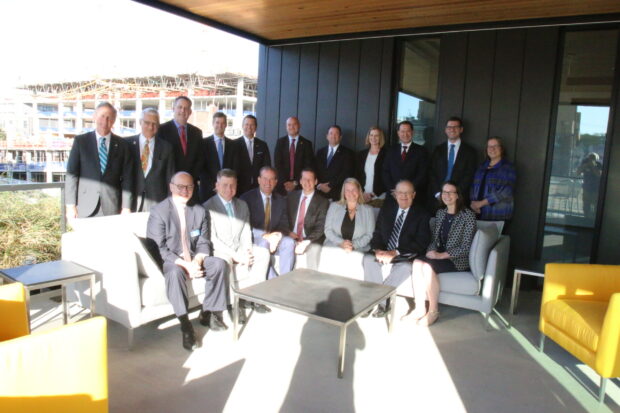
The standard description of a successful bank has long been one characterized as “boring”—no drama, no surprises, just fundamentally sound lending decisions that generate an ample return on investments and a healthy bottom line. Those were the days, eh? In large part because of forces beyond their control—from Washington, principally, but Jefferson City, Topeka, Wall Street and consumers on Main Street—banking has taken on a new, more electrifying role in the national and regional economy. Gathering to assess the broad sweep of those changes, a score of bankers and trusted advisers in banking law and accounting met Oct. 8 at Academy Bank’s beautiful new banking center in Downtown’s thriving Crossroads District. In a two-hour discussion led by chairmen Paul Holewinski of host Academy Bank, Bob Monroe of the banking practice at Stinson LLP, and Lyle Alexander of BKD, participants covered shifts in banking dynamics, technology, regulatory oversight, the quest for talent and much more that makes the job of banking executives today not for the faint of heart.
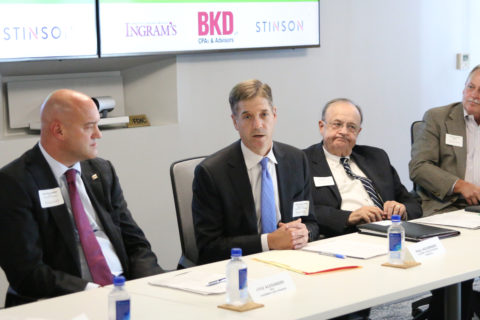
The co-chairs of the assembly: Lyle Alexander of BKD (left), Paul Holewinski of host Academy Bank, and Bob Monroe of Stinson.
Challenge and Opportunity
The most recent Ingram’s banking assembly took place two months after Donald Trump was sworn into office; today, with another presidential election barely 13 months out, the challenges for this sector bear some of the same hallmarks as then.
“The noise out there, the upcoming election, the trade issue. All those things—many don’t have any impact on us, but yet they impact our psyche, minds and thoughts,” said Bob Regnier, founder of Bank of Blue Valley. “I think a lot of the negativity, every time somebody talks about the looming recession, that’s a headwind we have.”
Yet within that construct, opportunities abound for the broader business community as well as banks.
“I think the opportunity here is for growing markets, as well as the M&A market,” said Julee Fox of BKD.
For Academy Bank’s Teresa Ascensio, “the biggest opportunity and looming concern are one and the same: the development of the shared prosperity throughout the region.” Groups like KC Rising, focusing on topics like work-force development, are providing hope, but “banks will play a very big part in that,” she said. The middle class dwindling and the divide between the impoverished and wealthy is growing at a very fast rate, she said, and banks can help by creating pathways to home ownership and supporting businesses owned by women and minorities.

Bob Regnier suggested that the “noise” about economic downturn was creating a climate of uncertainty among business executives.
“One concern I have is for the smaller banks, and that’s the ability to survive and compete with lager banks and a lot of the fintech companies,” said Stinson’s Katie Rizzo.
Yet those emerging companies have an upside for banks, said her Stinson colleague, Mike Lochmann, especially “in partnering with fintechs on the deposit-gathering or loan side. Every color of the rainbow is out there, and they all need a real bank to make it happen.
Geography, too, plays a part in this market: “One of the greatest opportunities is what’s going on East of Troost,” said Arvest Bank’s Mark Larrabee. “The opportunities with federal Opportunity Zones, the sales tax and the new mayor who’s from that area and is focused on redeveloping that area. Banks need to figure out a way to engage in that area where maybe they haven’t in the past.”
More specific to the banking executives interests, he noted, is the change in regional ownership dynamics. Most at the table referenced the region’s well-earned reputation for being “overbanked,” that is, having more bank brands operating per capita than you find in most major-city markets. “They used to be almost all locally owned,” Larrabee said. “Now, it’s almost 50-50 between out-of-town and locally owned.” Along with that change, major national brands like Chase and PNC have either moved operations into this region, or are about to.
Bill Ferguson, of Central Bank of the Midwest, radiated optimism for business in this region. “Kansas City has never been more poised for success; it just has incredible strength,” he said. “The business activity is picking up, building activity is picking up, The reputation of Kansas City is the best I’ve ever seen it.” But he shared Bob Regnier’s concern about back-ground noise. With the help of America’s business media, “we’re working really hard to talk ourselves into a recession,” he said. “That will make a self-fulfilling prophecy.”
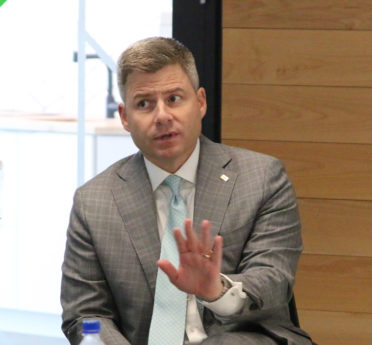
But for that uncertainty, said Jim Rine, the overall business climate in the Kansas City region remains quite strong.
BKD’s Brian Mall said these were the best of times if you have scale: “I haven’t seen banks so healthy in a long time. I think the strong will continue to get stronger by acquiring. The concern I have is succession planning. I think we’ll see a lot of smaller community banks go away, and what that will do to the community is hard to forecast.”
Academy Bank’s Dave Rambo sees tech trend as a way to connect with the client base and customers, but acknowledged: “Change is occurring at an extremely rapid pace and it’s tough to keep up with.”
Indeed, said Country Club Bank’s David Caffrey, Kansas City currently has “an incredible buzz.” For younger workers, he said, “it used to be you wanted to go to St. Louis and settled for Kansas City; now it’s the other way around.”
Karen Garrett’s world at Stinson entails emerging products and their delivery, so she’s intimately familiar with the regulatory aspect of that innovation. “I think some interesting stuff is going to happen with all the tech service providers, and the disruption will be bigger for them than for the banks, ultimately.” In the meantime, a bank’s ability to move to a consumer-friendly fintech platform, she said, “is table stakes” with today’s consumers.
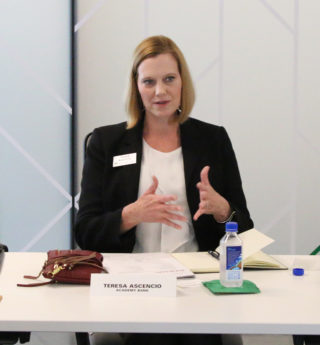
Teresa Ascensio said Academy Bank had pushed decision-making down in the organization, creating greater job satisfaction for young workers.
“The challenge with that is to figure out how to differentiate yourself from everybody else,” Garrett said. “If everybody can open accounts online and take small business applications online and every bank can take your mobile deposits, what makes a community bank still a community bank, and what is the reason to come to your bank instead of one of the big guys?”
Doing that, said BOK Financial Corp’s Kevin Kramer, means defining a strategy and focusing on it, especially in this market. “I think at one point, we had 120 different bank brands,” he said. While that figure has been pared to roughly 100 that’s still a highly competitive environment.
“Kansas City is very open to players in the market and that’s why I think we have so many different banks,” Kramer said. “It’s a very accepting community.”
And that spills over into attraction for new talent. “We’ve always had people in our organization who want to go to Denver, and they still want that, but now KC is having that younger set looking at Kansas City as a viable option to grow their career. That provides an opportunity for us.” A recent civic group’s trek to explore the buzz around Nashville convinced him, he said, that this region is on the right path. “Nashville is growing, but I like the way we’re growing better. I think that helps us as a sustainable market, so our challenge is with things we can’t control,” in particular, the regulatory reach from Jefferson City, Topeka and Washington in particular.
At BKD, a recent recruiting push involving 50 prospective hires, convinced Lyle Alexander that “the tables have really turned. They’re excited about the ability to come here.”
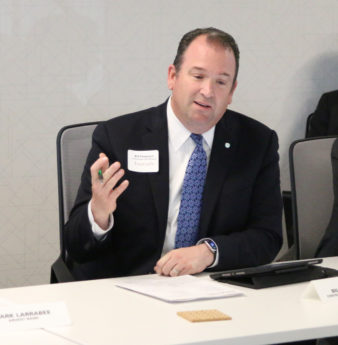
Bill Ferguson addressed the competitive threat of non-bank institutions.
Indeed, said Paul Holewinski, CEO of Academy Bank, the region has real strengths with is civic alignment—the Civic Council, Downtown Council, chambers of commerce and the Economic Development Corp. of Kansas City. One of the big take-aways from the Nashville trip, he said, was that “we’re doing things pretty good here, too. The challenge comes in keeping that momentum.”
Stinson’s Bob Monroe noted that succession planning isn’t just something affecting bank clients; community banks are caught up in it as well with their Baby Boomer ownership. “Planning is a big deal, and it’s important for the core of
the banking community here in Kansas City, to maintain the level of movement we’re in right now.”
UMB Bank’s Jim Rine connected some of the dots of that discussion by pointing out that one challenge for larger community banks—growing their deposit base—ties in directly with those ownership changes. “You can get all the retail deposits you want, at low cost, and consumer deposits,” he said. “Acquisitions are the easiest way to get those deposits. Also banks need scale—you need to spread your costs over more units. But for some banks, you’re too big to plug into someone else’s tech, or too small to compete with banks that have
an unlimited R&D budget.”
Downturn Concern
Is an economic downturn really coming, and if so, asked co-chairman Bob Monroe, what are banks doing today to prepare for it?
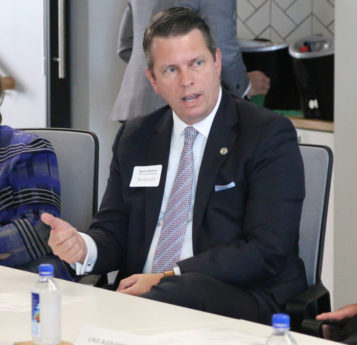
After years of low commodity prices, the regional farm economy is in trouble, said Kevin Kramer.
The Trump administration’s tough stance on China has raised a few welts on the economy’s hide, but Jim Rine noted that “customer base is still strong.” Companies by and large have passed tariff costs on to their clients, and while there has been a slowdown in the manufacturing sector, that represents just 18 percent of the market’s economy. Talk of a slowdown fuels uncertainty he said, and “but for the uncertainty, there are still very strong signs, especially in the construction sector, which still has backlogs pushing two years out.”
David Caffrey pointed to a bit of slowness in residential construction, “but for the most part, our customers still have huge backlogs and can’t find the people to do the work.” For clients with international operations in a time of trade friction, “we’re worried about the supply chain getting screwed up,” he said. “We have a lot of companies that bring shipments in, and it’s just one additional complexity added to what’s already complex.”
Kevin Kramer shared Mike Loch-mann’s concern about the health of the farm economy. “That’s a challenge with what happens with trade and tariffs,” he said, “but also with low prices. When you start talking about producers putting crops in the ground, it gets hard, especially with commodity prices so low, and they have been low for four or five years.” Farmers in that climate who have mortgaged their land to offset losses in income will find their options limited absent a pricing recovery. “That will dry up, too,” Kramer said. “That family farm, its getting harder and harder for them
to compete.”
Given that dynamic, do rural banks that may be stressed become acquisition targets?
“Some do,” said Kevin Kramer, “but it goes back to the deposit base. If it’s a nice base and something you can maintain in a smaller market, yes, there is an opportunity to make an acquisition. But if they’re pretty well loaned up and have a high concentration in that farming market, the multiples aren’t very good.
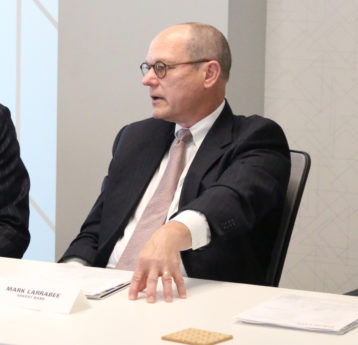
Banks would do well to invest in parts of Kansas City east of Troost, said Mark Larrabee.
That, he said, will crush the hopes of some owners looking to sell ahead of retirement. “Some family-owned banks have an expectation in terms of a multiple, and I don’t think it will be there for them,” he said.
Some rural banks in this region, noted Karen Garrett, “are very, very small. So small that it’s hard to consider them even viable branches for a larger bank.”
“Just speculating that in five years, lots of these smaller community banks are going to look around and want to sell, but nobody is going to raise their hands,” said Bob Monroe. “I’m kind of worried about people outside the metro areas. I think we’re going to see a big decline in those.”
Part of the challenge for smaller banks, said Bob Regnier, is the explosion in banking alternatives. “When you can get a loan at subprime rates from banking.com what’s the incentive for a younger person to move to the bank in some small town? I worry about community banking’s future, particularly in rural areas. Still, I think there’s a space for community banking in Kansas City.”
Lyle Alexander asked about the potential effects of a looming election cycle, prompting Bob Regnier’s obser-vation that “I don’t see the consumer spending slowing down. We have a 3.5 percent unemployment rate, and there are more jobs available in Kansas than there are unemployed people.” But, as Mike Lochmann, noted, there is a disconnect: “The skill sets are not matched” between open jobs and available workers.
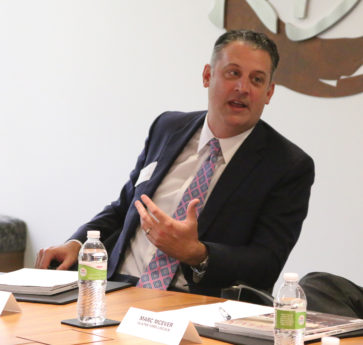
Abe Cole said one of the biggest emerging tasks for accounting and consulting firms was advising clients in cyber-security challenges.
Of greater concern for Regnier is a year or more of uncertainty about policy shifts that could emerge from the national election. “When you can’t see beyond six, nine or 12 months, why would you put a bunch of money into capital expenditures if, when that productivity finally comes
on line, you will not be able to use it?”
That dynamic was evident in 2016, said Mark Larrabee. “We had the election and things almost paused, but as soon as the election was settled, things then took off. I do think that deregulation has spurred a lot of activity we’re seeing. Can we sustain that until the next election?”
It doesn’t help in banking in particular, said Mike Lochmann, when a candidate like Elizabeth Warren is attacking banks
en masse. “She can go to war with Wells Fargo, fine, but we don’t have to have the same rules for the big four or five banks as for a $50 million community bank. She can’t seem to differentiate between those, and neither can the rest
of Washington.”
One broader issue related to the political climate is the so-called ESG movement, driven by activists pursuing their agenda in matters related to the environment, social causes and government. When you look at the heat maps of industries that could be affected, said Jim Rine, you begin to discern the potential for trouble. Among them, gun manufacturers, tobacco companies or the fossil-fuels industry. The pressure is most evident on publicly traded banks like UMB, he said, “to make a declaration as far as what you support or don’t support. It becomes a slippery slope with pressure to make your stance.”
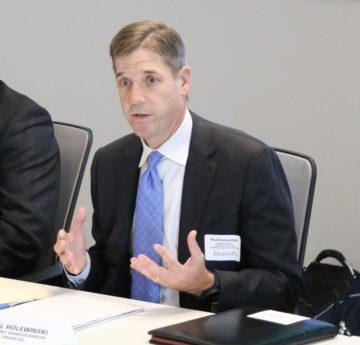
Regulations can be burdensome, Paul Holewinski noted, but they also help keep certain disruptive forces at bay.
How deep is that movement? Bob Regnier recounted a conversation with a client who said the traditional home-owner’s gas-powered lawn mower would likely be a thing of the past within a few years, as manufacturers bow to environmentalists’ concerns and move toward battery-powered mowers. “I can’t imagine gasoline or internal combustion engines going out of use, but the trend is there,” he said. “They’re calling for the demise of that industry.”
The Role of Tech
Change in banking technology is doing more than just improving operating efficiencies, participants said. As they have moved into Big Data status and fin-tech platforms, banks have regained some of the luster lost after the financial-services sector meltdown of 2008. That appeal is reaching young workers who might not have previously considered applying their tech skills in a banking environment.
The ability to laser in with data-driven looks at clients at a given level of deposits, said David Caffrey, has lead to more informed decisions and more focused strategies of improving client service and attracting new customers. “It’s a lot easier than is used to be,” he said, “and now we can be very strategic” in allocations of resources.
While fintech is proving a disruptor, it’s not a determinant, most agreed. “A lot of smaller banks have completely gotten out of the business of mortgage lending,” said Katie Rizzo. “That’s one area where non-banks have started making more mortgages than banks.” But because the non-banks can’t take deposits, banks retain a particular relevance. “They really have to partner with banks; they can’t do what banks do unless they form their own bank, though we’ve seen some of that happening.”

Unemployment may be near record lows, but many of the available jobs still require skills that jobless workers frequently lack, said Mike Lochmann.
Non-bank financial services will continue “to peel off a piece of business and price something we won’t be able to compete with,” said Bill Ferguson. “We need to focus on where we can make a difference and where we can bring in more business.”
Still, said Kevin Kramer, the banking industry has drawn some lines. “They’ve stepped up and decided they’re not going let non-banks take it. Venmo started to siphon off deposits from banks, and those banks allied with us starting Zelle.” Now, more banks are moving to that platform, and consumers are getting the safety and security of FDIC institutions
as they access funds.
Mark Larrabee said that the FDIC aspect was an important one, especially if there is an economic slowdown. “A lot of money outside the system isn’t insured,” he said. “If those companies fail, you’ll realize the real value of the banking system.“
Cumbersome at times, the regulation behind today’s banking, Paul Holewinski said, “also serves a pretty big security blanket for us as well. It does keep many of the fintechs out of our business directly. We pay for it through regulation, but it does slow the pace of change.”
As for the status of cash in modern society, he said, “you can go get cash in the checkout line, you can get cash a lot of different ways.” That’s dampening the appeal of certain on-line platforms, but a downside to that consumer trend is the drop-off in ATM usage.
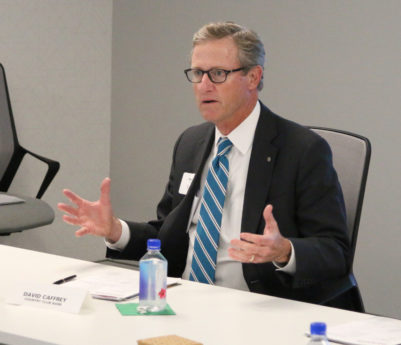
David Caffrey lauded the new types of tools that help banks bring a more strategic focus to resource allocation.
The other critical aspect of technological change, noted David Rambo, is the pace of it, with companies popping up and offering new widgets, but not necessarily having the staying power needed for banks that buy in. “It’s really a challenge to figure out who to partner with; the landscape changes so quickly, he said. “Are they going to be there in five years to support the platforms you use today? The vendor risk is incredible.”
“All these great fintech companies have come up with apps that are so cool,” said Kevin Kramer, “but they still need a backbone, and banks can provide that from time to time. They have a lot of great ideas, but when it comes to execution, they still need what banks can provide.”
Summarizing the laundry list of challenges, Jim Rine pointed to the over arching remedy: Successful banking, he said, continues to be driven by successful relationships. “Relationships matter. The ancillary products matter a lot more today, but it’s still about relationships.”
For consumers, he said, “price certainly matters, but there’s not that much difference in banking products. There might be a one-off product someone has the other guy doesn’t have, but I can’t think of anything that someone has that we don’t have that’s similar. Customers want value. If they’re not getting value from you, they are going to look for it from someone else. So what’s your differentiator? Whatever
their hierarchy of needs is, you have to deliver on that.”